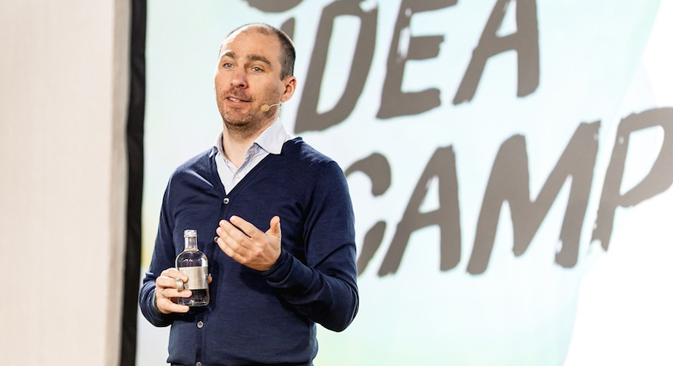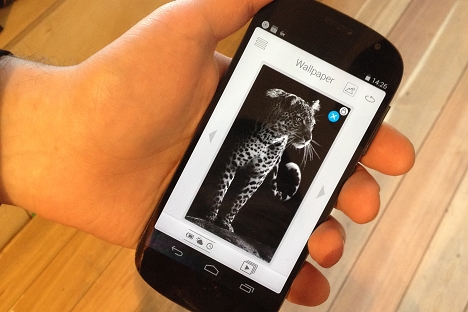
Yota Devices CEO Vlad Martynov said at the opening of the crowdsourcing platform Yota Idea Camp in Moscow on 27 March. Source: Andrei Baida
The first glimpse of the second model
RBTH correspondents have managed to get hold of a prototype of the second YotaPhone and see how it differs from its predecessor. The dual-screen smartphone, which has become slimmer and lighter, runs on the latest version of Android and is equipped with a quad-core Snapdragon 800 processor.
The screen size has been increased to 5 inches (the first model had a 4.4 inch screen). It now displays images in Full HD, and the sharp, brick-like edges of the smartphone body have been rounded, making the device more elegant and streamlined. The extra screen has also undergone some changes. Its resolution has been increased from 170 ppi to 235 ppi, which significantly enhances the quality of the monochrome display. The functionality of the second screen has also been expanded: Now it not only displays pictures, but can also be used as a control panel.

Meet YotaPhone 2. Source: Ekaterina Turusheva
As Yota Devices CEO Vlad Martynov said on 27 March at the opening of the crowdsourcing platform Yota Idea Camp in Moscow, the second version of the dual-screen YotaPhone smartphone is not supposed to be a niche product like the first version, but rather a gadget for the mass market. The retail launch of the new device is planned for late 2014.
Other retailers, including the largest chains in Russia, Yevroset and Svyaznoy, are skeptical about the chances of the new phone's success. The first YotaPhone failed to sell, partly because of a lack of any kind of marketing strategy.
However, Martynov believes that the phone needs no advertising or marketing support, as "the phone should sell itself". The company is adhering to this strategy with respect to the second phone as well. Whether this is an astute move is another matter - it is worth remembering that the first YotaPhone was not particularly popular among users, with a disappointing total of just over 12,000 devices having been sold in Russia and Europe by February 2014.
Fewer devices, better health
The main advantage of the YotaPhone, according to its developers, is the rear-facing e-ink screen, which makes it possible not only to save battery power, but also to check for updates without spending time unlocking the main color screen.
This feature of the YotaPhone has other advantages too, notes Daniel Seeberg, an American futurologist and IT expert, and the author of the book The Digital Diet, who also attended the opening of Idea Camp. Recently, the idea of spending less time using gadgets has been gaining traction: Studies show that a significant proportion of users even sacrifice personal communication with their friends or family for the internet, he says. Gadgets need to be productive, but they should not cut us off from the real world, and the Yota Devices product fits in well with this philosophy, he said.
Yota Devices also plans to assist users in monitoring their health. According to Martynov, the company's developers are already engaged in the development and introduction of software for the second model that will allow YotaPhone owners to monitor the amount of calories they burn and the number of kilometers they walk. The handset itself will make the calculations without requiring the use of any additional devices.
Technology without politics
Despite the fact that the YotaPhone has often been called the first Russian smartphone, the creators of the gadget prefer to position it as a universal, global product.
Martynov claims that the company does not intend to respond to recent calls by Russian officials and public figures to boycott American goods (including smartphones) because of the political situation, saying that there are no plans to offer users incentives to switch to the YotaPhone.
“We do not make the product exclusively for Russian users. The YotaPhone needs to be competitive in the global market place,” says Martynov.
“Speaking about foreign, mainly U.S. users, they are unlikely to choose the YotaPhone or reject it for political reasons,” says Tim Olsen, a scientific adviser for Crowdsourcing.org. “The differences between Russian, American and other technologies are becoming fewer and fewer,” he says.
The price of the matter
Martynov said that the new second-generation YotaPhone would cost about the same or be slightly cheaper than Android smartphones with similar technical specifications from leading manufacturers.
For comparison, the Sony Xperia Z1 and LG G2 smartphones, which are similar to the YotaPhone 2 in terms of their technical characteristics, are currently priced in Russia at around 25,000 rubles ($700) and 20,000 rubles ($560) respectively, but by the end of the year these gadgets will be superseded by newer models and their prices will drop.
Released in December 2013, the YotaPhone has become known as Russia's first smartphone with two screens – a standard display as well as a black-and-white e-ink display which is always on. The first generation YotaPhone was aimed primarily at early adopters – technologically advanced users interested in new products in the gadget market.
The presentation of the first dual-screen YotaPhone.
All rights reserved by Rossiyskaya Gazeta.
Subscribe
to our newsletter!
Get the week's best stories straight to your inbox